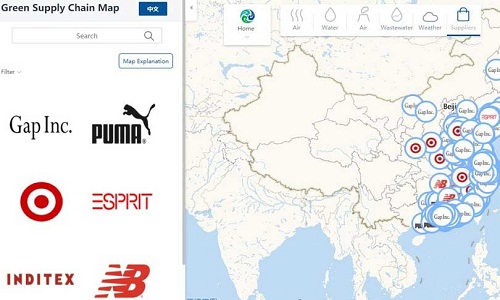"IPE Green Supply Chain Map links major fashion brands such as Target, Esprit, New Balance, PUMA, Gap Inc, and Inditex with their suppliers’ environmental performance. Kurt Kipka, Senior Project Manager – Responsible Sourcing Initiative, NRDC, says each brand conducts a mapping process against a database of Chinese facilities that have publicly available real-time monitoring. In most cases, the brands have already made these lists available to the general public. In that case, the map simply takes existing information and improves upon its usability."

IPE Green Supply Chain Map links major fashion brands such as Target, Esprit, New Balance, PUMA, Gap Inc, and Inditex with their suppliers’ environmental performance. Kurt Kipka, Senior Project Manager – Responsible Sourcing Initiative, NRDC, says each brand conducts a mapping process against a database of Chinese facilities that have publicly available real-time monitoring. In most cases, the brands have already made these lists available to the general public. In that case, the map simply takes existing information and improves upon its usability. Access to data is a critical step in both identifying and curtailing highly polluting practices in the textile supply chain.

Increased transparency As per NRDC and IPE, with China expanding its industrial manufacturing base, as much as 25 per cent of carbon emissions have been linked to the manufacture of products for export. Air, water, and soil pollution problems have emerged. The impact was mentioned in the Ellen MacArthur Foundation’s Circular Fibers Initiative reports as well. Heavy chemical use is involved in making other cellulose-based fibers, in particular viscose. The processes used to make these fibers extract cellulose from trees or other plants using a variety of process-specific chemicals. By connecting supplier lists with publicly available information, brands and eventually consumers can use the tool to reduce the global impact of textile manufacturing by making more informed purchasing decisions.
The IPE Green Supply Chain Map, having English and Chinese versions, offers companies real-time information to ensure environmentally responsible operations from afar. When used correctly, the IPE Green Supply Chain Map can reduce the time and expense associated with factory audits, which often don’t identify hidden problems as well.
The functionality
With the help of data from the Chinese government, IPE’s database and map show real-time data and historical trends in air pollution emissions and wastewater discharge for nearly 15,000 major industrial facilities in China. The database also has environmental supervision records for more than 500,000 additional facilities. So far, the response for the map has been good.
One of the potential advantages of the IPE Green Supply Chain Map for participating brands is just-in-time identification of potentially egregious supply chain oversight and management issues. Recognising these issues can drastically reduce the time it takes brands to collaboratively address the concerns with their business partners, added Kipka. In addition, joining the map underscores a brand’s commitment to setting and upholding standards of performance. Although the map in its early stages of development, the company hopes it inspires more companies to follow the leadership of its inaugural brands and volunteer their supply lists to the effort. The company hopes that it should also be beneficial for other countries to adopt such a map and manage their supply chain eco-measures.












